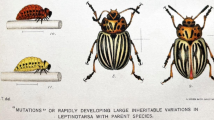Summary
The relative fitnes of genotypes is a function of the genotypic frequencies of two consecutive generations and of the rate of outcrossing. The use of mean values for cross-fertilization can lead to wrong estimates of fitness values if the mating system depends on the genotype. Using experimentally obtained genotypic frequencies, the infuence of mistaken estimates of outcrossing rates on the fitness value are investigated and discussed in this paper. These results showed that a very cautious interpretation is necessary if one uses pooled values of outcrossing rather than those pertaining to each individual genotype, especially when there are small differences between the relative fitness values and large genetic variability in the mating systems.
Zusammenfassung
Die relative „fitness” von Genotypen ist eine Funktion der Genotypenfrequenzen zweier aufeinander folgender Generationen und der Fremdbefruchtungsrate. Die Berücksichtigung von Durchschnittswerten rate. Die Berücksichtigung von Durchschnittswerten für die Fremdbefruchtung kann bei vom Genotyp abhängendem Befruchtungssystem zu Fehlschätzungen der Fitnesswerte führen. Unter Verwendung von experimentell ermittelten Genotypenhäufigkeiten wird in vorliegender Arbeit der Einfluß einer Feschätzung der Fremdbefruchtungshäufigkeit auf den Fitnesswert untersucht und diskutiert. Dabei ergab sich, daß vor allem bei geringen Differenzen zwischen den relativen Fitnesswerten sowie großer genetisch bedingter Variabilität des Befruchtungssystems eine vorsichtige Interpretation notwendig ist, wenn anstelle der dem Genotyp eigenen Fremdbefruchtungs-rate lediglich ein gemeinsamer Wert berücksichtigt wird.
Similar content being viewed by others
Literatur
Allard, R. W.: Inheritance of some seed-coat colors and patterns in lima beans. Hilgardia22, 167–177 (1953).
Allard, R. W., andP. L. Workman: Population studies in predominantly self-pollinated species. IV. Seasonal fluctuations in estimated values of genetic parameters in lima bean populations. Evolution17, 470–480 (1963).
Fyfe, J. L., andN. T. J. Bailey: Plant breeding studies in leguminous forage crops. I. Natural crossing in winter beans. J. Agric. Sci.41, 371–378 (1951).
Haldane, J. B. S.: The mathematical theory of natural and artificial selection. Part I and Part II. Prog. Cambridge Phil. Soc.23, 19–41 and 158–163 (1924).
Harding, J., andC. L. Tucker: Quantitative studies on mating systems. I. Evidence for the non-randomness of outcrossing inPhaseolus lunatus. Heredity19, 369–381 (1964).
Hayman, B. I.: Mixed selfing and random mating when homozygotes are at a disadvantage. Heredity7, 185–192 (1953).
Imam, A. G., andR. W. Allard. Population studies in predominantly self-pollinated species. VI. Genetic variability between and within natural populations of wild oats from differing habitats in California. Genetics51, 49–62 (1965).
Jain, S. K., andR. W. Allard: Population studies in predominantly selfpollinated species. I. Evidence for heterozygote advantage in a closed population of barley. Proc. Nat. Acad. Sci.46, 1371–1377 (1960).
Rick, C. M.: Rates of natural cross pollination of tomatoes in various localities in California as measured by the fruits and seeds set on male sterile plants. Proc. Am. Soc. Hort. Sci.54, 237–242 (1949).
Tucker, C. L., andJ. Harding. Quantitative studies on mating systems. II. Estimation of fitness parameters in a population ofPhaseolus lunatus Heredity20, 393–402 (1965).
Wöhrmann, K., undR. W. Allard: im Druck.
Workman, P. L., andR. W. Allard: Population studies in predominantly self-pollinated species. III. A matrix model for mixed selfing and random outcrossing. Proc. Nat. Acad. Sci.48, 1318–1325 (1962).
Author information
Authors and Affiliations
Rights and permissions
About this article
Cite this article
Wöhrmann, K. Fremdbefruchtungsrate und genotypische „fitness”. Züchter / Genet. Breed. Res. 37, 142–145 (1967). https://doi.org/10.1007/BF02440098
Issue Date:
DOI: https://doi.org/10.1007/BF02440098




